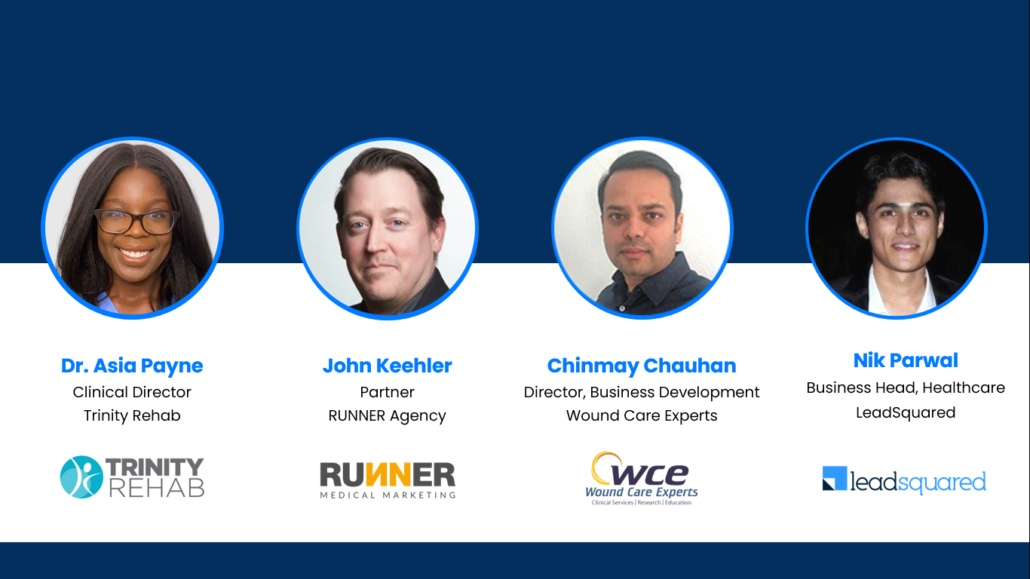Speakers:
Key Takeaways:
In this panel discussion we bring together some of the brightest minds in marketing and operations, to discuss challenges, trends and the way forward for predictable patient acquisition and retention.
“Stopping advertising to save money is like stopping your watch to save time.”
The famous quote by Henry Ford holds true for organizations across all industries, including healthcare.
Acquiring patients is one of the pillars of success in patient-centered healthcare.
John Keehler, Partner and Chief Strategy Officer of Runner Medical Marketing, commenced the webinar by urging his fellow panelists to share their thoughts on the marketing challenges they faced in acquisition.
Challenges as mentioned by the panelists
“The follow-up. We see the patient once, and then the patient continuing with us is a gamble, a toss-up,” noted Chinmay.
He vividly explained how even though a business grows over the years, the challenges remain the same. Gathering from experience, he stated that the ability to complete treatment has always been the biggest challenge.
Dr. Asia Payne added how new companies find it difficult to even get people to know they exist.
Competing with larger health systems is a big problem. More often than not, these big competitors have their own departments for specific medical services. Anybody there can provide a prescription to the patient, and they can just go down the hall to the provider within the organization.
“We have to find creative ways to target those patients without necessarily aggravating our referral sources and not stepping on the toes of some of our bigger competitors that beat us out with branding and marketing,” says Dr. Payne. To continue her input to the discussion, John requested Dr. Payne to share channels and strategies she uses in terms of the patient admission.
Strategies to overcome the challenges
“Most of my marketing is actually directed to the consumer,” says Dr. Payne.
The channels she mentioned using include:
These channels allow her to not market directly to doctors.
According to her, it’s a more grassroots approach to getting your name out there and more fruitful.
Dr. Payne added that this approach helped her build long-lasting relationships with current and potential patients.
“What does a community event look for you right now, how do you get the word out about it?” asked John.
Dr. Payne described how for health fairs, she uses social media and ads on WMMR, Pennsylvania, to let people know that Trinity Rehab will be there at those events.
She explains how most people turning up at these events are interested in their health and looking for healthcare providers.
“I’m able to reach patients that way.”
This approach is also what is known as reverse marketing.
Instead of connecting with the doctor, Dr. Payne connects with the patients and goes backward to reach the source of their referral.
Referral Portal
It is also a very feasible tactic timewise.
Patients get the care they need within 48 hours.
In this part of the conversation, Dr. Payne nicely explained how her approach has worked out for her, earning her almost five new patients each event. “Its all about that time aspect, it works very great especially for new offices and clinics who have no client base, and the patients love it!” concludes Dr. Asia Payne
The Success of Marketing Channels
Following the webinar, John conducted an engaging poll for the audience.
Poll Results
In the meantime, Nikhil posed a question to the panelists asked by someone from the audience – “How would you target and try to reach Medicare only, not Medicare Advantage, with a reasonable CPL and good quality with channels, etc.?”
“Medicare Advantage is actually easier to target but Medicare is the golden goose, right?” started answering Chinmay.
He explained how his approach is different from Dr. Payne’s.
Chinmay recommends finding all kinds of clinics around and coordinating to establish a connection with them.
‘They have limitations, but they have the audience that you want.”
This way, patients will come directly to the service provider, and they will not have to ‘micro down’ on which patient to target.
John chimed in with his thoughts on the topic – “If one of the questions being asked related to that is, how do you use let’s say, how do you target that in paid advertising? I think my response to that question would be, there are a couple ways of approaching it.”
If there are any restrictions, the provider must communicate that to the people up front.
Having the data set up is essential to feed back into the campaign.
Talking about the results of the poll question he had previously asked, John observed how most people used Google Search Ads as their preferred channel to market.
He explained how Google Search Ads allow the user to feed data back to Google and fetch a higher quality lead using the advertising algorithms to get them to the right place.
Directing a probe toward Chinmay, John says, “talk to me about a medical director strategy you have where you kind of create this offer to start the relationship, and then you add services in, I would call this kind of a land and expand strategy, right for referrals.”
Chinmay explained how his audience consisted of several people dealing with mental health and telehealth.
It is essential to have the right medical staff for the right position.
“All my staff, especially the providers gets at least a month of just training on this specialty.”
Another strategy he mentioned was putting themselves as a free service in the medical director position.
“On the ground strategy for me was going to a facility, offering free medical directorship, giving them the person that they can consult with then offering service directly to those patients, while we’re offering the service, the facilities aren’t getting charged, we can work with insurances.”
Once they had enough volume of patients, they could negotiate with insurance and work out a better understanding, stated Chinmay.
John addressed how Chinmay had previously mentioned learning at the beginning of a relationship with a patient.
Chinmay expressed that his main goal is to provide a service without financially burdening the patient or giving a budget hit to the facility.
Talking about his more recent strategy, he said he takes pride in giving the best service possible.
His mantra is if a patient is already dealing with ailments, let’s not give them other burdens to worry about.
Channel marketing, in this case, is the key.
Advocating LeadSquared, he said, “Anybody can steer a ship as the good captain that gets you to navigate to your goal.”An excellent follow-up system is the main requirement to heal patients in an allocated timeline.
HIPAA Compliance
“What LeadSquared offers is that captain at the helm, we are getting that help, and I’m willing to pay for it because I’m paying for the captain. I’m not paying for the technology; that’s what’s lacking on my end,” adds Chinmay
Developing Relationships into Meaningful Referrals
“It’s like dating,” lightheartedly puts forth Dr. Asia Payne.
She went on to explain how, like dating, it’s sometimes just a waste of time talking to a lead.
It’s understandable for a provider to dislike a particular patient.
The patient, on the other hand, in just one visit, can end up deciding that they are not getting any help and go around bad-mouthing the provider or the team.
Dr. Payne concluded that it takes her a minimum of six months to recognize if the patient engagement is actually going somewhere.
Going back to another highly-voted answer in the poll, John talked about SEO.
SEO is a long-term strategy.
“You’ve got to be in it for the long haul, to really see results there,” remarked John. Moving forward with the conversation, he asked Dr. Asia and Chinmay to share their challenges with lead handling.
Challenges in lead handling, as listed by panelists
This means that giving up after a call or two will not yield fruitful results.
“My metrics for adding direct scheduling to our website translates to two leads a month, which, for all intents purposes, it’s not a metric. It’s just a roll of a dice,” says Chinmay.
John chimed in, “One thing I’m a big advocate of is people communicating with patients via the means that they want to communicate, and we’re seeing more and more of that kind of activity through text messaging.”
He shared a story about a guy who got lost in Grand Teton National Park earlier that year.
He kept declining calls from the police because it was from an unknown number.
The bar has just been raised regarding how often the provider has to call people back.
In this case, text messaging has worked really well for anyone associated with telehealth. It works for traditional practices too.
The CRM side of telehealth tools is the need of the hour, as it offers the expertise that providers lack.
Methods of Effective Lead Handling
John initiated the next poll for the audience –
Poll Results
In the meantime, adding to the lead handling topic, Dr. Payne said that a lot of it has to do with timing.
She had observed that 24 to 48 hours of response time is the sweet spot because that’s when people are looking.
Not following up with a patient fast enough could lead to them canceling an appointment.
Patient Communication
Dr. Payne states that she is a proud proponent of anything technology because it makes communicating easier.
Changing the method of lead handling can significantly improve the success of marketing.
If a provider can double their lead conversion rate, then they can get a lot more out of their investment in advertising.
Effective strategies
At this point, John vividly explains the importance of healthcare marketing automation to take care of the timing Dr. Payne talked about.
Towards the end of the session, the panelists discussed the use case of the several review platforms available for patients today.
“The use of social media and just virtual treatment as an option to get new patients, because it creates accessibility and increases awareness for not only your services but people’s health in general” is exciting for Dr. Payne.
Talking about other channels and his goals for the future, Chinmay said, “The next target for me is getting very exact, geographically targeted Google Ads, social media advertisement to get those patients because we know they’re going to need it.”
Nikhil Parwal concluded the webinar by leaving everyone with the thought of LeadSquared.
Patient Intake Automation
LeadSquared is a patient management system that is doing many interesting things around marketing and patient on-boarding.
For a walk through the platform, or any queries, book a demo today.
More about the panelists







